
95% of researchers rate our articles as excellent or good
Learn more about the work of our research integrity team to safeguard the quality of each article we publish.
Find out more
ORIGINAL RESEARCH article
Front. Psychol. , 21 October 2015
Sec. Cultural Psychology
Volume 6 - 2015 | https://doi.org/10.3389/fpsyg.2015.01490
This article is part of the Research Topic Cultural change: Adapting to it, coping with it, resisting it, and driving it. View all 14 articles
Part of this article's content has been mentioned in:
Temporal Changes in Individualism and Their Ramification in Japan: Rising Individualism and Conflicts with Persisting Collectivism
 Yuji Ogihara1,2*
Yuji Ogihara1,2* Hiroyo Fujita1
Hiroyo Fujita1 Hitoshi Tominaga3
Hitoshi Tominaga3 Sho Ishigaki4
Sho Ishigaki4 Takuya Kashimoto4
Takuya Kashimoto4 Ayano Takahashi4
Ayano Takahashi4 Kyoko Toyohara4
Kyoko Toyohara4 Yukiko Uchida5
Yukiko Uchida5We examined whether Japanese culture has become more individualistic by investigating how the practice of naming babies has changed over time. Cultural psychology has revealed substantial cultural variation in human psychology and behavior, emphasizing the mutual construction of socio-cultural environment and mind. However, much of the past research did not account for the fact that culture is changing. Indeed, archival data on behavior (e.g., divorce rates) suggest a rise in individualism in the U.S. and Japan. In addition to archival data, cultural products (which express an individual’s psyche and behavior outside the head; e.g., advertising) can also reveal cultural change. However, little research has investigated the changes in individualism in East Asia using cultural products. To reveal the dynamic aspects of culture, it is important to present temporal data across cultures. In this study, we examined baby names as a cultural product. If Japanese culture has become more individualistic, parents would be expected to give their children unique names. Using two databases, we calculated the rate of popular baby names between 2004 and 2013. Both databases released the rankings of popular names and their rates within the sample. As Japanese names are generally comprised of both written Chinese characters and their pronunciations, we analyzed these two separately. We found that the rate of popular Chinese characters increased, whereas the rate of popular pronunciations decreased. However, only the rate of popular pronunciations was associated with a previously validated collectivism index. Moreover, we examined the pronunciation variation of common combinations of Chinese characters and the written form variation of common pronunciations. We found that the variation of written forms decreased, whereas the variation of pronunciations increased over time. Taken together, these results showed that parents are giving their children unique names by pairing common Chinese characters with uncommon pronunciations, which indicates an increase in individualism in Japan.
Cultural psychology has revealed substantial cultural variation in human psychology and behavior, emphasizing the mutual construction of socio-cultural environment and mind (Kitayama and Cohen, 2007; Heine, 2011). However, most previous research compared psychology and behavior only at a single point in time, which did not account for the fact that culture is dynamic and changing (see Greenfield, 2009). Considering that cultural psychology is a discipline that aims to explore how culture and mind make each other up (Shweder, 1990), cultural change should also be examined. Investigating how cultures change and how people adapt to such changes can contribute to cultural psychology, which leads to a better understanding of human nature.
Cultural change has been demonstrated empirically with analyses of archival data. For example, Gentile et al. (2010) did a meta-analysis of scores on the Rosenberg Self-Esteem Scale (Rosenberg, 1965) between 1988 and 2008 among American middle school, high school, and college students. They showed that self-esteem had increased among adolescents and young adults in the U.S., caused by the cultural emphasis on self-worth over time.
However, examining archival data has limitations because it is not always the case that same items have been used consistently over the years. Hence, research has started to focus on cultural products as a desirable means of investigating cultural change. Cultural products are defined as “tangible, public representations of culture such as advertising or popular texts” (Morling and Lamoreaux, 2008, p. 199). Psyches and behaviors are reflected in cultural products, so cultural products enable researchers to investigate psyches and behaviors outside the head. Moreover, cultural products are tangible aspects of culture, so they persist over time. For instance, Twenge et al. (2012, 2013) examined how frequently individualistic words/phrases and first singular pronouns, which are thought to reflect individualistic tendency (Kashima and Kashima, 1998), have been used in books written in American English from 1960 to 2008, and found that American culture has become more individualistic. Similarly, the frequency of individualistic words in books also indicated the urbanization and cultural change toward greater individualism in the U.S. and UK (Greenfield, 2013). Researchers have used not only books but also other cultural products, such as song lyrics (DeWall et al., 2011) and dictionary (Oishi et al., 2013), to examine cultural change.
Has Japan experienced a cultural shift toward greater individualism as European–American cultures have? Past research repeatedly showed that cultures in Europe and North America have become more individualistic (e.g., Gentile et al., 2010; Twenge et al., 2012, 2013; Greenfield, 2013). Yet, few studies have examined empirically whether East Asian cultures have become more individualistic.
Similar to other countries, Japan has been affected by globalization. In particular, Japan has a strong political and economic relationship with the U.S., so Japanese culture has been tremendously influenced by American culture. Hence, individualistic values and systems have flowed into Japanese society. For example, Japanese companies have imported a performance-based salary system that is based on individualistic concepts (e.g., Japan Productivity Center, 2013), and schools have put more emphasis on children’s uniqueness and independence (e.g., Doi, 2004). Moreover, it has been suggested that economic wealth promotes individualism (e.g., Inglehart and Baker, 2000; Greenfield, 2009; Grossmann and Varnum, 2015). If individuals have sufficient wealth, the need for interdependence should relatively decrease. Japan experienced gradual economic growth after World War II. Although the rate of economic growth slowed after 1990s, relative wealth has still increased (e.g., inflation-adjusted GDP per capita has increased). Hence, it is expected that Japanese culture has gradually become more individualistic.
Secondary analysis of archival data has shown that Japanese culture became more individualistic, at least in some respects1 from the 1950 to 2000s (Hamamura, 2012). For example, family size decreased, divorce rate increased, and the ratio of people who live in urban areas increased.
However, little research has investigated cultural change concerning individualism in East Asia, which makes it unclear whether East Asian culture has become more individualistic. As we noted above, using archival data to describe cultural change has its limitations, but these limitations can be overcome by examining cultural products. Conducting investigations from different approaches with different variables should increase the generalizability of the previous finding (Hamamura, 2012). Moreover, to reveal dynamic aspects of culture, it is important to present temporal data across cultures. Therefore, it is necessary to investigate changes in individualism, not only in European–American cultures but also in East Asian cultures.
The present research focuses on the names of people as an index of individualism. Names are rich sources of information. They can signal gender, ethnicity, or class (Kasof, 1993). In addition, names affect psychological, social, and economic consequences (for a review, see Christenfeld and Larsen, 2008). For example, people with easy-to-pronounce names are judged positively and are associated with social success (the name-pronunciation effect; Laham et al., 2012). Moreover, parents’ values or orientations are reflected in the first names they choose for their children (Lieberson and Bell, 1992). Thus, names can be regarded as a behavioral measure of important parental choices and decisions, not only for their babies, but also for themselves.
In individualistic cultures, uniqueness is important (e.g., Kim and Markus, 1999). Previous research demonstrated that the uniqueness of children’s first names is a valid index of individualism. Varnum and Kitayama (2011) conducted a state-level analysis of the relationship between the rate of common names and individualistic tendency, and found that common names are given less frequently to children in more individualistic frontier states in both the U.S. and Canada. In other words, unique names are more likely to be given in more individualistic states (e.g., those in the Mountain West and the Pacific Northwest). Furthermore, they indicated that common names are given less frequently (i.e., unique names are given more frequently) in more individualistic countries2.
If a culture has become more individualistic, the rate of parents who give common names to their children should decrease. In fact, prior research showed that in the U.S., the rate of giving common names to babies decreased from 1880 to 2007, suggesting an increase in uniqueness and individualism3 in the U.S. (Twenge et al., 2010).
In the present research, we investigated whether Japanese culture has become more individualistic by examining changes in names as a cultural product. We predicted that, consistent with previous research (especially the results of behavioral measures; Hamamura, 2012), Japanese culture has become more individualistic. Specifically, we hypothesized that the rate of parents who give their children common names would have decreased over time.
Due to the Japanese writing and reading system, we examined names using three indices and these indices were examined separately. As most Japanese names are written using Chinese characters (kanji), the first index is the combination of Chinese characters (e.g., the combination of “大” and “翔” to create “大翔”). In addition, each Chinese character (e.g., “大” and “翔”) has a meaning (e.g., “大” represents big or large, and “翔” represents to fly or a wing), so each Chinese character was also examined for the second index. For the third index, we examined the verbal pronunciation of the name. This is because even if the same Chinese character is used, the verbal pronunciation or reading of that character can differ, as many Chinese characters used in Japan (i.e., kanji) have multiple possible pronunciations. For instance, the possible pronunciations for “大翔” include “Hiroto,” “Haruto,” “Yamato,” and “Tsubasa.” This is because parents can freely assign a pronunciation to any given Chinese character (this practice is legally permitted). Each Chinese character has a common or typical pronunciation, but parents can provide an uncommon pronunciation other than the typical pronunciation. Thus, it is necessary to examine not only Chinese characters but also their pronunciations.
We predicted that unique names would have increased over time. Yet, there were three ways of giving unique names in the Japanese cultural context. Hence, we conducted an examination to determine which strategy was more prevalent. In the first way, parents can give both unique written Chinese characters and a unique pronunciation, whereby uniqueness is expressed both in writing and reading. In the second way, parents can give a name with common pronunciation, but which is written with unique Chinese characters. In other words, uniqueness is expressed in writing rather than in reading. In order to make names unique, it is not always necessary to give both unique Chinese characters and unique pronunciations. Even if the pronunciation is same, if it is written with different characters, the name should be unique. This is similar to the different spellings of common names in the European–American cultural context (e.g., Caitlin, Caitlyn, Kaitlin, Kaitlyn, Kaitlynn, Katelyn, and Katelynn). In the third way, parents can give a common written name that has a unique pronunciation. That is, parents give common Chinese characters but read them in a unique way. We should consider each component (i.e., Chinese characters, pronunciation) holistically as a name, especially in cultures that have a writing system based on Chinese characters. Even if the same Chinese character is used, the readings of that character can be different because many Chinese characters used in Japan (i.e., kanji) have multiple possible pronunciations. This practice is different from the European–American cultural practice, in that the written characters do not always lead to the same pronunciation of that character. Parents can freely assign a pronunciation to a given Chinese character. Each Chinese character has its standard or common pronunciation, but parents can give an uncommon pronunciation that differs from the usual pronunciation. Therefore, giving a name comprised of common Chinese characters but an uncommon reading is sufficient to make it unique.
Unlike in the U.S. where the government (the Social Security Administration) publishes a database capturing nearly the entire population (Twenge et al., 2010; Social Security Administration, 2013), it was impossible to collect name data for the entire population of babies in Japan. Hence, we used data from private companies that collected the names of newborns each year. In Japan, two such databases were available. One is from the Benesse Corporation, which deals with goods and services for babies and their parents. The other is from the Meiji Yasuda Life Insurance Company, which deals with insurance. The sample size of the Benesse data was large, but that of Meiji Yasuda was relatively small. Thus in Study 1, we investigated whether names have become more unique in Japan by examining the Benesse data. Moreover, in Study 2 we replicated Study 1 using the Meiji Yasuda data, which were collected independently of Study 1.
Data was retrieved from the Benesse Corporation’s website which is publicly available (Benesse Corporation, 2013). They collect baby names from customers who bought their products, such as toys, books, and nursery items. They published rankings of the most common first names (and their rates of use) given to newborns each year over 9 years, from 2005 to 20134. Sample sizes in each year are shown in Table 1. Approximately 40,000 names of newborns were collected each year during this period. Currently, about 1,000,000 babies are born in Japan each year (Ministry of Health, Labour and Welfare, 2014a). Therefore, a sample size of 40,000, which is the equivalent of 4% of the entire population of interest, is large.
We calculated the rate of popular given names each year in Japan. As we noted earlier, due to the Japanese writing and reading system, we examined three indices (the combination of Chinese characters, individual Chinese characters, and verbal pronunciation) separately. Concerning the combination of Chinese characters, the company published a ranking of the top 100 most common combinations of Chinese characters5. In line with prior works (Twenge et al., 2010; Varnum and Kitayama, 2011), the top 10 ranking was used in the present study. In terms of individual Chinese characters, the company displayed the top 50 most common Chinese characters in 2005, the top 100 from 2006 to 2008, and the top 20 from 2009 to 2012. To examine changes over time and compare results among the three indices, the top 10 names were used in our analysis. With regard to verbal pronunciation, the company published the top 100 most common pronunciations from 2005 to 2008 and the top 20 from 2009 to 2013. To examine changes over time and compare results among three indices, we used changes in the top 10 rankings as an index of change6.
We followed procedures used in the earlier work by Hamamura (2012) to distinguish whether common names are increasing, decreasing, or not changing in prevalence. First, we computed an ecological correlation (correlation with year) that indicated a linear trend for each index over time. In this calculation, each score was weighted by the sample size of its respective year to give a proportionally higher weight to the samples with more names than those with fewer names (e.g., Gentile et al., 2010). As a conventional criterion, indices with correlations below |0.10| were operationalized as showing no change7 (Hamamura, 2012). Furthermore, we calculated the annual change, which captures the absolute magnitude of change. Even if high ecological correlations are found, if the absolute magnitude of change is small, this should be interpreted as showing a lack of change. In other words, we have to consider not only linear trends, but also the slope of change. We conducted a simple regression analysis predicting each score by year (i.e., y = Bx + c, where y = each score of the name index, B = the unstandardized regression coefficient, x = the year, and c = the regression constant). We used unstandardized regression coefficients as rates of annual change8. As with ecological correlation, indices with annual rates of less than 0.1% were operationalized as showing no change (Hamamura, 2012). In addition, we inspected a scatter plot of the relation between year and each name index to check whether other patterns of change were present (e.g., U-shaped).
In addition, to check whether temporal changes of common names are an indicator of uniqueness/individualism in Japan, we tested whether changes in unique name rates were related to changes in previously validated indices of individualism. Previous research developed the Japanese Collectivism Scale (JCS; Yamawaki, 2012) which measures prefectural-level (similar to state-level in the U.S.) collectivism by modeling Vandello and Cohen (1999)’s American Collectivism Index. This scale is constructed of five indicators (divorce to marriage ratio, percentage of elderly living alone, percentage of nuclear family households, percentage of people living alone, percentage of three-generation households) and was validated both at the individual and prefectural level. This scale was also used to examine cultural change in Japan (Hitokoto and Tanaka-Matsumi, 2014). Following previous research, we calculated the annual JCS for each year from 2005 to 2013, and computed the correlations between each index and the JCS9. The data on divorce to marriage ratio was obtained from the Ministry of Health, Labour and Welfare (2014a), and other data were obtained from the Ministry of Health, Labour and Welfare (2014b). In line with the prior work (Hamamura, 2012), correlations of more than |0.30| was used as a conventional criterion.
Changes in the percentage of parents who gave the top 10 most common combinations of Chinese characters are shown in Table 2; Figure 110. Correlations with the year were positive, but their changes were small in magnitude. Therefore, the results revealed that the rate of parents who chose common combinations of Chinese characters did not change over time.

TABLE 2. Average rates (%), correlations with year (r), and annual changes (%) of top 10 common names in Study 1 and 2.
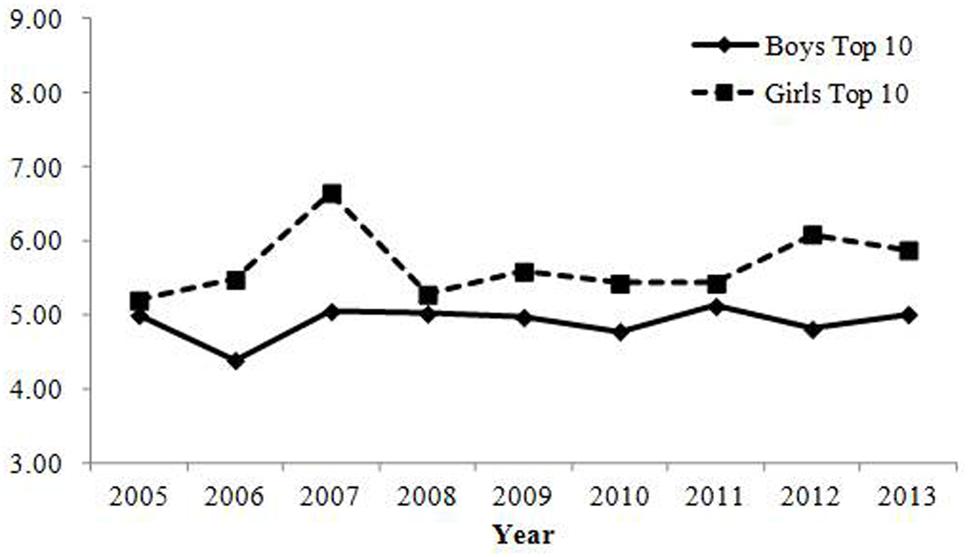
FIGURE 1. Percentage of babies receiving names with one of the top 10 most common combinations of Chinese characters in Study 1. Changes were small in magnitude, showing that the rate of parents who give common combinations of Chinese characters has not changed over time.
Changes in the percentage of parents who gave the top 10 most common Chinese characters are shown in Table 2; Figure 2. Both correlations were positive and annual changes were sufficiently large11. Thus, the results indicated that the rate of parents giving common Chinese characters increased over the years.
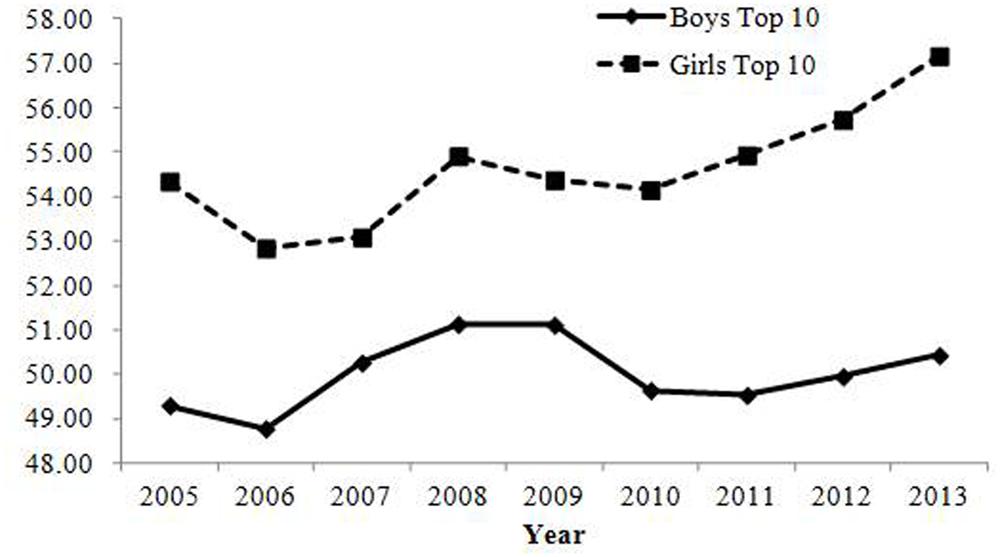
FIGURE 2. Percentage of babies receiving names with one of the top 10 most common Chinese characters (individual character) in Study 1. The rate of babies with common Chinese characters has increased and changes were sufficiently large in magnitude.
Changes in the percentage of parents who gave the top 10 most common pronunciations are shown in Table 2; Figure 3. Both correlations were negative and annual changes were sufficiently large, showing that the rate of parents who gave common pronunciations decreased over the years.
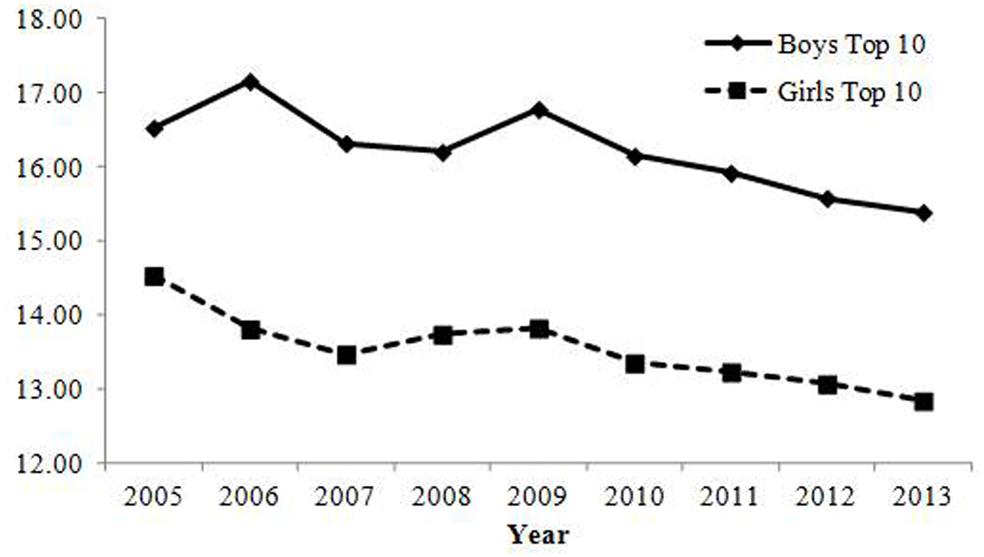
FIGURE 3. Percentage of babies receiving names with one of the top 10 most common pronunciations in Study 1. The rate of babies with common pronunciation has decreased and changes were sufficiently large in magnitude.
The rate of common names might be associated with other factors other than individualism. For instance, it has been shown that economic wealth promotes individualism (e.g., Inglehart and Baker, 2000; Greenfield, 2009; Grossmann and Varnum, 2015). In fact, past research indicated that GDP per capita was negatively correlated with the rate of common names (Varnum and Kitayama, 2011). Economic wealth and individualism are related with each other, but they are conceptually different. Furthermore, parents might spend more time choosing names for their children when they have only one child than they do when they have two or three children.
First, we computed simple correlations between the year, GDP per capita (inflation adjusted; Cabinet Office, Government of Japan, 2014), birth rate (Ministry of Health, Labour and Welfare, 2014a) and each of the three naming indicators (Table 3). We found that GDP per capita was negatively related to the rates of the common pronunciations, regardless of gender. This result was consistent with the idea that economic wealth promotes individualism (e.g., Inglehart and Baker, 2000; Greenfield, 2009; Grossmann and Varnum, 2015) and the past finding (Varnum and Kitayama, 2011). In addition, birth rate was positively associated with the rate of common pronunciations.
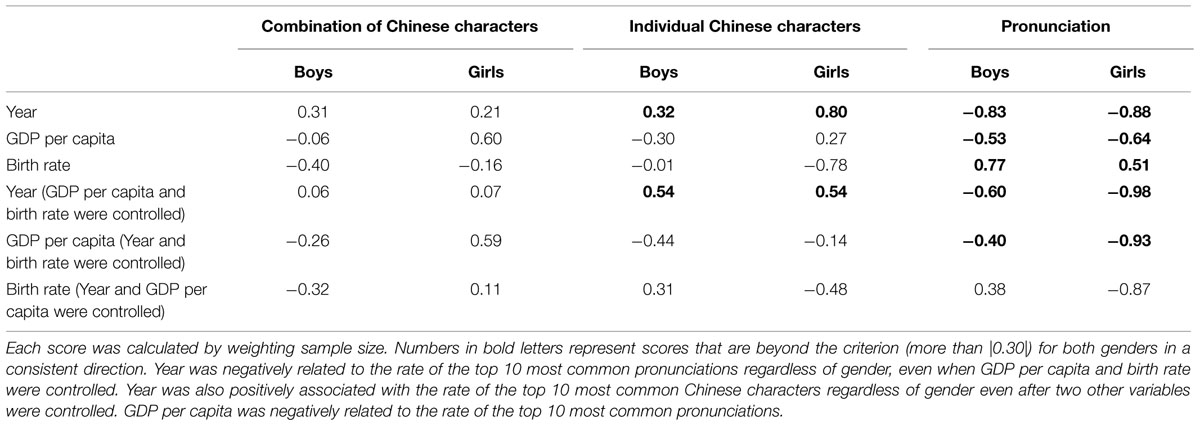
TABLE 3. Simple and partial correlations between year, GDP per capita, birth rate, and each name index in Study 1.
Next, we calculated partial correlations between the year and each of the three naming indices while controlling for GDP per capita and birth rate (Table 3). The pattern of the results was consistent with the original results obtained from simple correlations for pronunciation and individual Chinese characters. In terms of common combinations of Chinese character, the absolute magnitude of correlations became smaller and was below the criterion.
We computed correlations between each index and the JCS (Table 4)12. Results indicated that the rates of the top 10 most common pronunciations in both boys’ and girls’ names were positively related to the JCS. That is, giving names with popular pronunciations was associated with collectivism.

TABLE 4. Correlation coefficients between each index of name and Japanese Collectivism Scale (JCS; Yamawaki, 2012) in Study 1 and 2.
In contrast, the rates of the top 10 most common combinations of Chinese characters for boys were negatively associated with the JCS. This pattern ran contrary to that which should have been expected (i.e., that the phenomenon of many parents using common combinations of Chinese characters in children’s names should be indicative of collectivism). Thus, giving common combinations of Chinese characters for boys cannot be seen as an index of collectivism13. The rates of the top 10 most common combinations of Chinese characters for girls were not associated with the JCS.
The rates of the top 10 most common individual Chinese characters was not associated with the JCS for boys and was negatively associated with the JCS for girls. This pattern for girls was contrary to that which should have been expected (i.e., that the phenomenon of many parents using common Chinese characters in children’s names should be considered as a sign of collectivism). Thus, giving names with common Chinese characters cannot be seen as an index of collectivism14.
These results demonstrated that only the rates of the top 10 most common pronunciations can be seen as an index of collectivism.
We found that the rate of parents who gave common pronunciations decreased. Further, this index was positively correlated with the previously validated collectivism index. In contrast, the rate of parents who gave common Chinese characters increased, but this index was not associated with the previously validated collectivism index. These results demonstrated that uniqueness as an aspect of individualism has increased over the years in Japan. Further, these changes remained prominent even when GDP per capita and birth rate were controlled.
In order to replicate the findings of Study 1, we analyzed changes in baby names from another large-sample survey similarly as in Study 1.
Data was retrieved from the Meiji Yasuda Life Insurance Company’s website which is publicly available (Meiji Yasuda Life Insurance Company, 2013). They collected baby names from people holding insurance policies with the company. Thus, the sample was different from that in Study 115 (data from educational service company). Sample sizes for each year are shown in Table 1. They collected about 8,000 names of newborns each year.
We examined two indices for names: the combination of Chinese characters and the pronunciation (the ranking of each Chinese character was not released in this data set). The top 100 combinations of Chinese characters and the top 50 pronunciations were available for each year. As in Study 1, we used the top 10 rankings.
In addition, Meiji Yasuda offers two kinds of information that were not available from Study 1 samples. First, we assessed the number of writing variations for the top 3 most common pronunciations. For example, a given name pronounced as “Yui” was written in 24 variations (such as “結衣,” “優衣,” and “唯”) in the 2013 samples of girls’ names. We counted how many variations were represented among the top 3 most common pronunciations. Second, we assessed the number of pronunciation variations for the top 10 most common combinations of Chinese characters in each year. For instance, “大翔” was pronounced with six variations (such as “Hiroto,” “Daito,” “Haruto,” “Yamato,” “Taiga,” and “Masato”) in the 2013 samples of boys’ names. We counted how many variations were included among the top 10 most common combinations of Chinese characters in each year. Further, we assessed the number of names that had more than two different pronunciation variants among the top 10 (some combinations of Chinese characters were read in only one fashion; e.g., “蓮 (Ren)” and “颯太 (Souta)” in the 2013 samples of boys’ names).
Changes in the percentage of parents who gave one of the top 10 most common combinations of Chinese characters are shown in Table 2; Figure 4. No indices reached the criteria for change with regard to ecological correlation and annual change. Therefore, consistent with Study 1, the results showed that the rate of parents who gave common combinations of Chinese characters did not change over time.
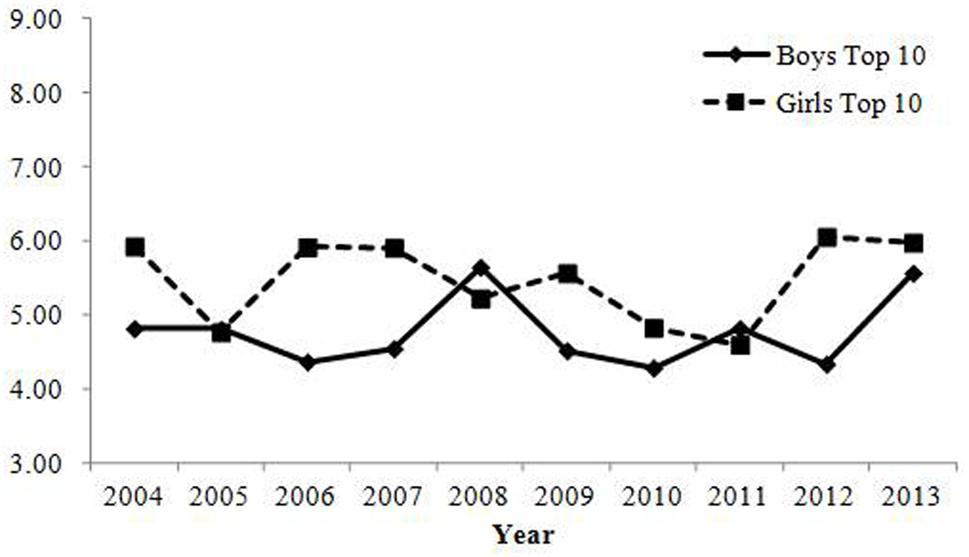
FIGURE 4. Percentage of babies receiving names with one of the top 10 most common combinations of Chinese characters in Study 2. Changes were small in magnitude, showing that the rate of parents who give common combinations of Chinese characters has not changed over time.
Changes in the percentage of parents who gave one of the top 10 most common pronunciations are presented in Table 2; Figure 5. Negative correlations in boys’ names revealed that the rate of parents who gave common pronunciations decreased, which is consistent with Study 1. In contrast to Study 1, there was not a negative correlation between year and the rate of the top 10 most common pronunciations and declining annual change for girls’ names. As shown in Figure 5, there were greater fluctuations for girls’ names relative to boys’ names. Indeed, there were 13 variations of names within the top 10 because of duplicated rankings (two 5th and five 9th ranked names) in 2013, 12 names in 2008 and 2011, and 11 names in 2004, 2007, and 2010. This was not the case for the boys’ names (11 variations in 2004, 2007 and 2012) and in Study 1 (not at all for boys’ names; only one case for girls’ names in 2005 with 11 variations). The rates of the top 10 most common pronunciations for girls were lower than those for boys (this was the case for both Study 1 and 2), and the sample sizes for girls were slightly smaller than those for boys. Hence, the possibility of having duplicated rankings due to the relatively small sample sizes was higher for girls’ names than for boys’ names. These reasons might lead to this inconsistency in the results for girls’ names between Study 1 and 2.
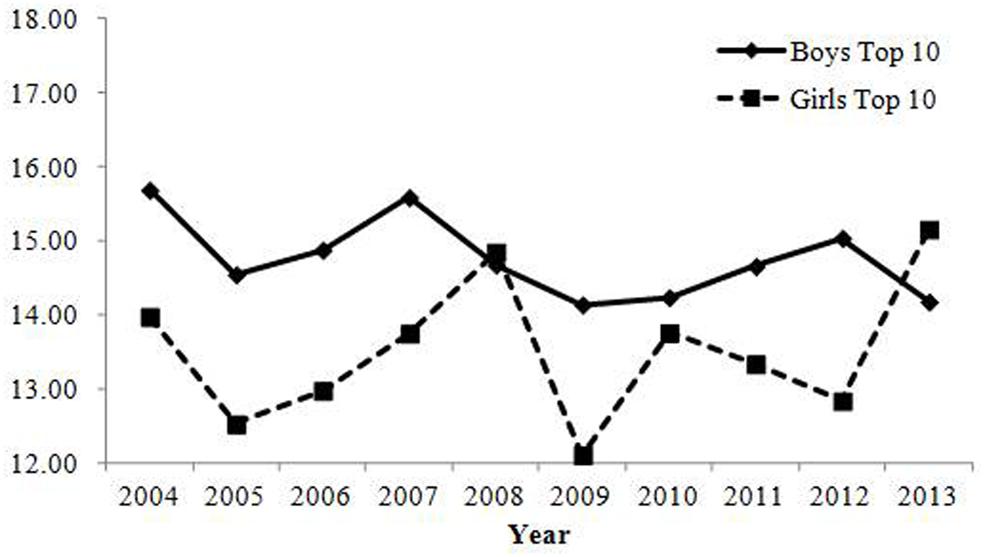
FIGURE 5. Percentage of babies receiving names with one of the top 10 most common pronunciations in Study 2. The rate of babies with common pronunciation in boys has decreased and changes were sufficiently large in magnitude. In contrast, the correlation between year and the rate of babies with common pronunciations in girls were below the criterion. However, it should be noted that there were greater fluctuations due to the inclusion of many duplicated rankings.
As in Study 1, partial correlations between year and each name index were computed, controlling for GDP per capita (inflation adjusted; Cabinet Office, Government of Japan, 2014) and birth rate (Ministry of Health, Labour and Welfare, 2014a). Concerning the combination of Chinese characters, partial correlations were consistent with the result obtained from simple correlations (rboy = 0.21, rgirl = 0.11). In terms of pronunciation, partial correlation between year and rate of common pronunciations was consistent with the result obtained from a simple correlation for boys’ names (r = -0.43). In contrast, the partial correlation was positive for girls’ names (r = 0.47). This inconsistency was probably caused by the inclusion of more than 10 variations among the top 10 rankings, as we mentioned above.
As in Study 1, we calculated the correlations between each index and the JCS (Table 4). Results showed that the rates of the top 10 pronunciations in boys’ names were positively related to the JCS, but those in girls’ names were negatively related to the JCS (this inconsistency may also have arisen because of the inclusion of more than 10 pronunciation variations in the top 10 rankings). In contrast, the rates of the top 10 most common combinations of Chinese character were not associated with the JCS, regardless of gender.
Changes in how much the written form of the top 3 most common pronunciations varied are shown in Table 5; Figure 6. Both for boys and girls, correlations between the year and the square average variation were negative, suggesting that parents tend not to seek uniqueness in the written form of names.
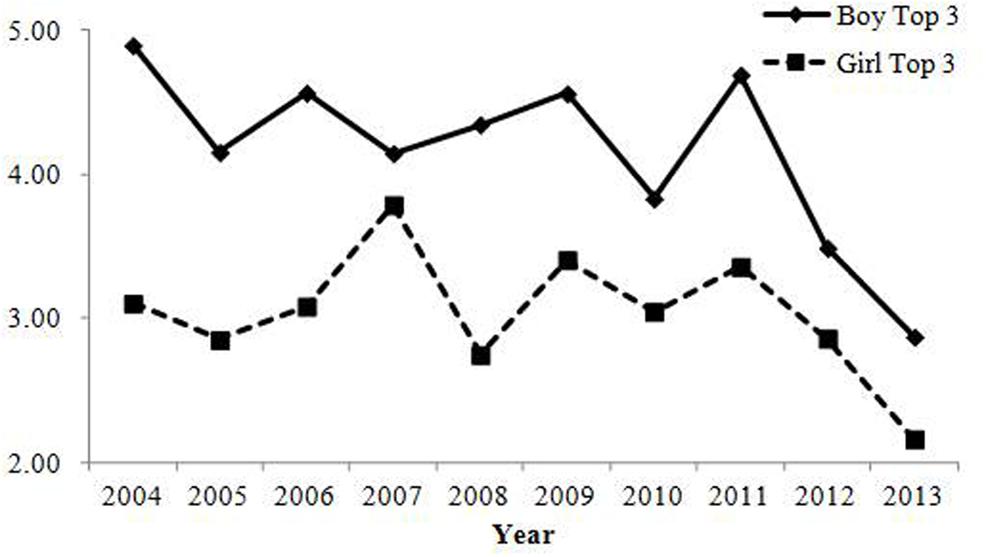
FIGURE 6. Square average variations of written forms for names with one of the top 3 most common pronunciations in Study 2. Variations of written form decreased over time for both in boys’ and girls’ names.
Changes in pronunciation variation are shown in Table 6; Figure 7. For girls, the correlation between the year and the average variation of readings was positive, which suggests that recently parents in Japan sought uniqueness with regard to the pronunciation of names. Moreover, the correlation between the year and prevalence of names that have more than two readings was positive and had a large annual change (Table 6; Figure 8). For boys’ names, the correlation between the year and the average variation of readings was negative. Yet, the correlation between the year and the prevalence of names that have more than two readings was positive and its annual change was sufficiently large. The negative correlation between the year and the average variation of readings might be caused by a ceiling effect, which is implied by Figure 7. In summary, variations in the pronunciation of the top 10 most common combinations of Chinese characters increased.
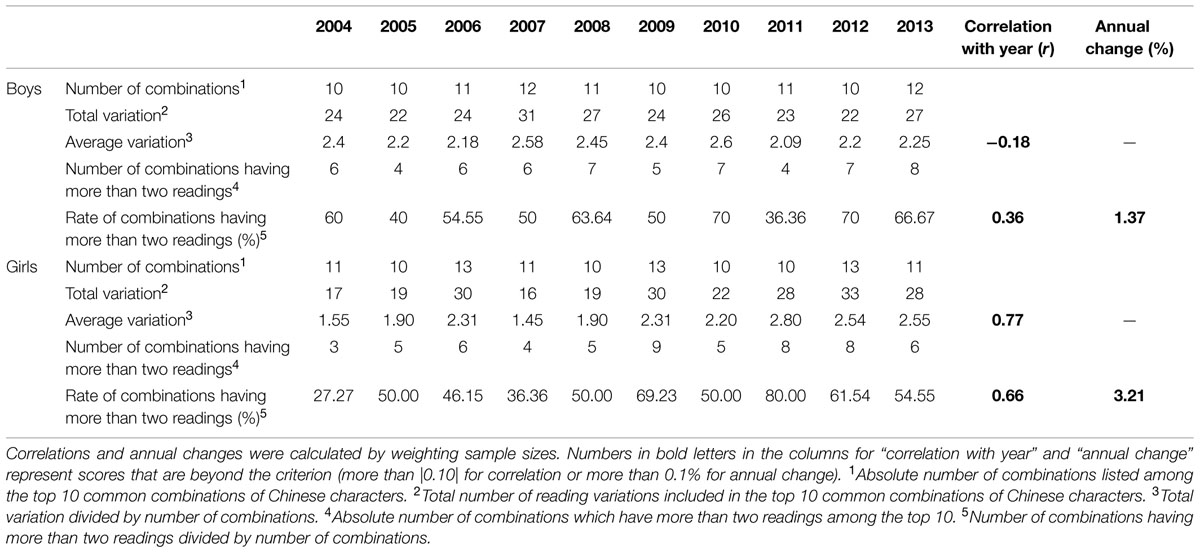
TABLE 6. Variations of pronunciation in the top 10 most common combinations of Chinese characters (Study 2).
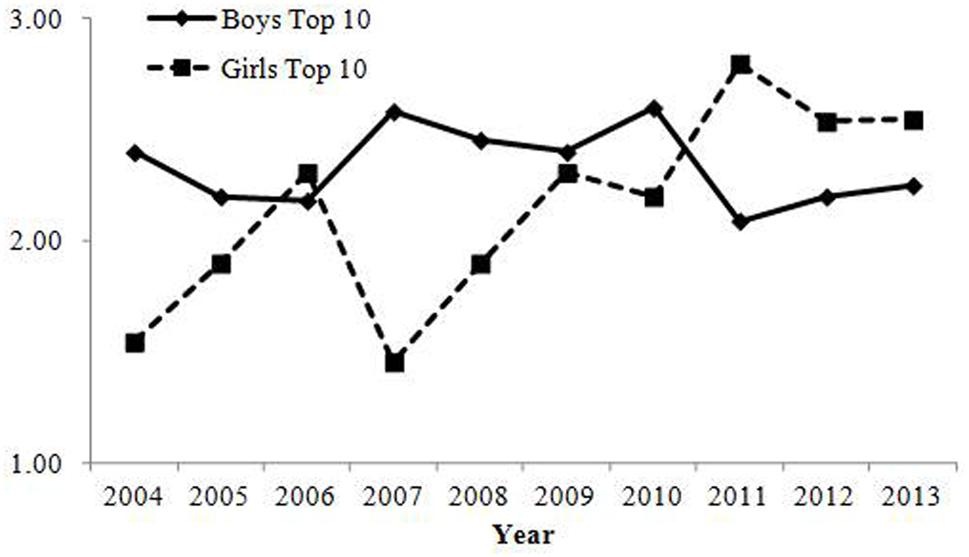
FIGURE 7. Average variations of pronunciations in names in the top 10 most common combinations of Chinese characters in Study 2. Pronunciation variation of girls’ names increased over time. In contrast, variation in boys decreased. Around 2.5 variations seem to be the ceiling.
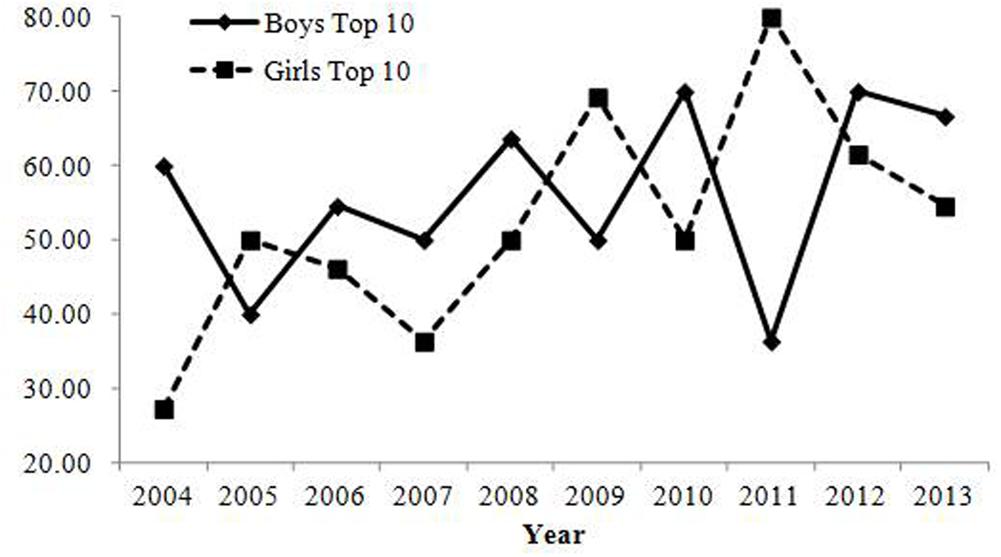
FIGURE 8. Percentage of names having more than two pronunciations among the top 10 most common combinations of Chinese characters in Study 2. The number of names with several pronunciations increased both for boys and girls over the years.
The results were relatively unstable because sample sizes were small (approximately 4,000 for each gender) compared to those in Study 1 (approximately 20,000 for each gender). If we examined the average scores (e.g., average score of the self-esteem scale), about 4,000 samples is relatively large. Yet, in the current research, we investigated the ranking of common names and their rates. Thus, 4,000 names would yield duplicated names of the same ranks. This would lead to the inconsistent results for female names (the decrease in the rate of common pronunciations over time and the positive relationship between the rate of common pronunciations and the JCS would both be rendered absent). However, in line with Study 1, Japanese parents were more likely to give their boys names with uncommon pronunciations. Further, by investigating changes in the variations of common combinations of Chinese characters and pronunciations, we obtained the result that variations in the pronunciation have increased over time while variations in the written form have decreased. This indicates that parents express uniqueness in pronunciation rather than in writing.
We examined whether Japanese culture has become more individualistic by investigating temporal changes of baby names as a cultural product. Across two independent samples from an educational service company and an insurance service company, the results were consistent. Specifically, we found that the rates of parents who gave common pronunciations have decreased. In addition, these rates were positively associated with a previously validated index of collectivism (JCS; Yamawaki, 2012) indicating that this index is valid to measure collectivism. In contrast, the rate of parents who gave common Chinese characters (not combination) has increased in Study 1. However, these rates were not positively associated with the JCS, showing that this index is not valid to measure collectivism. Taken together, it is revealed that Japanese culture has put more emphasis on uniqueness and has become more individualistic.
Japanese parents seem to provide unique names by giving common Chinese characters with uncommon pronunciations, which is consistent with an observation from linguistics (Sato, 2007). If parents give names written with common Chinese characters and pronounced in a traditional way, then the rates of common pronunciation should increase. However, they did not increase, but rather decreased. Hence, parents give names with common Chinese characters to their babies but pronounce them uniquely. We obtained results consistent with this conclusion with different measurements. In Study 2, we examined both the selection of Chinese characters and their pronunciation at the same time. We found that pronunciation variations of common combinations of Chinese characters increased over time, suggesting that Japanese parents assign unique pronunciations to the Chinese characters. In order to make names unique, giving both unique Chinese characters and unique pronunciations is not always necessary. People do not express uniqueness in all domains, but do so in a domain where people expect others would notice and recognize the uniqueness. For example, people often display uniqueness by choosing to wear uncommon clothes or have an uncommon hairstyle, but do not express uniqueness in uncommon choices of what dish to eat first at dinner (because people usually do not care what others eat first in everyday situations). Previous studies showed that people with a high need for uniqueness tend to choose a unique favorite professional baseball team, novel, food, color, town, and so on (Okamoto, 1985; Yamaoka, 1993). Yet, they also note that need for uniqueness was not necessarily associated with uniqueness of all targets or domains. They did not find relationships in terms of favorite country, favorite holiday activity, and favorite party or meeting. Giving both uncommon Chinese characters and an uncommon pronunciation simultaneously may make names so unique as to make even an experienced Japanese speaker unable to read them in an appropriate way, which would be undesirable and problematic.
One example of giving common Chinese characters with uncommon pronunciations is the recent phenomenon of some parents in Japan giving English pronunciations to Chinese characters, which was a previously uncommon practice (Sato, 2007; Tamago Kurabu, 2013). For example, Japanese normally pronounce “海 (meaning sea or marine)” as “Kai” or “Umi” but some parents pronounce it as “Marin” in Japanese, after the English word “marine.” Another example that illustrates the practice of pairing common Chinese characters with uncommon pronunciations is that of parents shortening the pronunciation (Sato, 2007; Benesse Corporation, 2012, 2013). For instance, “心 (meaning mind or psyche)” is usually read as “Kokoro” but can be uniquely read as “Ko” or “Koko” and used as such in “心春 (Koharu)” and “心愛 (Kokoa).” In these ways, Japanese parents seem to provide unique names.
There are at least two reasons why parents in Japan show uniqueness through pronunciation rather than through Chinese characters. First, the number of Chinese characters that Japanese parents can choose from is limited by the Japanese government (2997 characters; Ministry of Justice, 2013). However, they are free (in that there are no legal restrictions against it) to give a novel pronunciation to a given Chinese character, thus creating a unique pronunciation, but not a unique written form (Sato, 2007). Second, uniqueness in the pronunciation might be more effective and prominent than uniqueness in the Chinese character (Sato, 2007; Kobayashi, 2009). That is because uniqueness in the Chinese character is not apparent in daily communication, but uniqueness in pronunciation does manifest in daily interactions. A person’s name may be called out or spoken more frequently than his or her name is written in face-to-face communication. All things considered, recent parents in Japan are more likely to provide unique names by giving uncommon pronunciations with common Chinese characters, which suggests a rise in uniqueness and individualism in Japan16,17. We do not mean that Japanese culture has become entirely individualistic. Rather, we suggest that Japanese culture has gradually become more individualistic.
To our knowledge, this is the first study to empirically investigate cultural changes in individualism in a Japanese cultural context through the examination of a cultural product. Previous studies have repeatedly shown that European American cultures have become more individualistic over time (e.g., Gentile et al., 2010; Twenge et al., 2010, 2012, 2013; DeWall et al., 2011; Greenfield, 2013; Oishi et al., 2013). However, little research has investigated whether East Asian cultures have become more individualistic by examining cultural products. We used baby names as a cultural product and revealed that not only in European–American cultural contexts, but also in an East Asian cultural context, culture is changing toward greater individualism. Our research empirically demonstrated temporal changes in individualism in an East Asian cultural context, which enables researchers to compare how culture changes across cultures. Therefore, our research contributes to revealing the dynamic aspects of culture. Moreover, cultural change toward greater individualism in historically individualistic cultures and collectivistic cultures may have different implications (Ogihara and Uchida, 2014; Ogihara et al., 2014). Hence, it is important to present empirical data showing the rise of individualism not only in European American cultures, but also in East Asian cultures that have been historically collectivistic (Hofstede, 1980; Triandis, 1995).
We presented empirical data showing the possibility that there has been an increase in unique names in Japan18. In present-day Japan, very unique names are sometimes called “kirakira names (shining names)” and attract a lot of attention, not only from scientists, but also from lay people. On the one hand, kirakira names have some merits, such as having a strong impression and being remembered easily by others. On the other hand, kirakira names are so unique and uncommon that others cannot read them properly, which may cause serious problems, such as not being able to be read or called out in the event of an emergency, and even not being hired by a company because of their name. It is said that despite having such costs, a growing number of parents give such kirakira names to their children. The practice or custom of naming in Japan – especially the recent practice of providing unique names – has been extensively reported and studied in fields such as sociology and anthropology (e.g., Kobayashi, 2009), linguistics (e.g., Sato, 2007), and Japanese studies (e.g., Sakata, 2006; Ohto, 2012). Yet, most research has not examined empirical data. In this sense, our study connects several disciplines to each other from a perspective of cultural psychology, and contributes to a better understanding of Japanese naming practices and culture by providing empirical evidence.
This study implies that the way to express uniqueness depends on the socio-cultural environment. We suggest that recently, parents in Japan express uniqueness by giving novel pronunciations to common Chinese characters. In China, which uses a related Chinese character-based writing system, parents can choose Chinese characters without restriction but cannot freely assign new pronunciation to them. Therefore, it is said that Chinese parents try to give unique names by providing uncommon Chinese characters (Lafraniere, 2009), which is a different way of expressing uniqueness than in Japan. This example of Chinese naming practices has not yet been examined through empirical evidence, so this would be a future direction and conceptual extension of the current research.
We presented empirical data on how parents try to give unique names in Japan. Within the two databases we analyzed, parents are more likely to give unique names by pairing uncommon pronunciations with common Chinese characters. In other words, parents do not seem to give unique Chinese characters to their babies in Japan. Some newspapers, magazines, and people have anecdotally reported parents giving uncommon Chinese characters. However, the present research provided no evidence for this as a mainstream trend, at least in the present samples. Sharing the domain of expressing uniqueness is necessary to efficiently show their uniqueness in the social contexts. In this sense, we provided the important information that uniqueness is expressed more in pronunciation rather than in Chinese characters recently in Japan to persons who try to give unique names.
This research examined cultural change over a relatively short period of time (2004–2013). This was because there are many difficulties in collecting older data in Japan unlike in the U.S. where the government (the Social Security Administration) has systematically collected and released the ranking of common baby names of almost an entire population (about 4 million) from 1880 to 2013 (Twenge et al., 2010; Social Security Administration, 2013). However, even in a brief period, we found a meaningful change toward greater individualism. In the future, it would be desirable to examine a longer span of data on Japanese baby names.
Another limitation is the possibility that the result was driven by changes in the sample used, rather than by changes in Japanese culture as a whole. It might be possible that the sample of parents who buy Benesse Corporation’s products and Meiji Yasuda Life Insurance’s products might have changed over time. However, the results were consistent across both studies, which were drawn from independent samples, suggesting that our findings were unlikely to be biased by sample-specific characteristics.
Future studies should also examine the social and psychological consequences of having a unique name. On the one hand, unique names that are not challenging to read might be positively regarded in that such names convey independence and uniqueness. On the other hand, overly unique names such as kirakira names may have negative connotations that parents who give kirakira names are not well-educated, because of an assumption that names should be readable while kirakira names are difficult or impossible to read. Standing out in a not-yet-fully individualistic culture might be related to some negative impacts (Ogihara and Uchida, 2014; Ogihara et al., 2014). To reveal how cultures change and how people adapt to such changes, it is also important to investigate the adaptiveness of unique names.
YO conceived and designed this research. YO analyzed the data. All authors interpreted the results. YO wrote the first manuscript and YU provided critical revisions. All authors approved the final version of the manuscript.
The authors declare that the research was conducted in the absence of any commercial or financial relationships that could be construed as a potential conflict of interest.
YO was supported by a Grant-in-Aid for Japan Society for the Promotion of Science fellows (JSPS KAKENHI Grant Number 26-5799). We thank Kosuke Takemura, Vinai Norasakkunkit, Beth Morling, Shota Uono, Masataka Nakayama, Tobias Heikamp, Pamela Taylor, and Kimberly Bowen for their helpful comments on earlier versions of this manuscript.
The Supplementary Material for this article can be found online at: http://journal.frontiersin.org/article/10.3389/fpsyg.2015.01490
Benesse Corporation (2012). Tamahiyo no Naduke in 2012 [Naming of Tamahiyo 2012]. Available at: http://women.benesse.ne.jp/event/hakase/rank2012/index.html [accessed September 30, 2014].
Benesse Corporation (2013). Tamahiyo no Naduke in 2013 [Naming of Tamahiyo 2013]. Available at: http://women.benesse.ne.jp/event/hakase/rank2013/index.html [accessed September 30, 2014].
Benesse Holdings (2015). Report on Financial Accounts for March, 2015. Available at: http://www.benesse-hd.co.jp/en/index.html [accessed May 2, 2015].
Cabinet Office, Government of Japan (2014). Kokumin Keizai Keisan [National Accounts of Japan]. Available at: http://www.esri.cao.go.jp/jp/sna/menu.html [accessed September 30, 2014].
DeWall, C. N., Pond, R. S. Jr., Campbell, W. K., and Twenge, J. M. (2011). Tuning in to psychological change: linguistic markers of psychological traits and emotions over time in popular US song lyrics. Psychol. Aesthet. Creat. Arts 5, 200–207. doi: 10.1037/a0023195
Doi, T. (2004). Kosei wo Aorareru Kodomotachi [Children Who are Abetted to Have Uniqueness]. Tokyo: Iwanami Syoten.
Gentile, B., Twenge, J. M., and Campbell, W. K. (2010). Birth cohort differences in self-esteem, 1988–2008: a cross-temporal meta-analysis. Rev. Gen. Psychol. 14, 261–268. doi: 10.1037/a0019919
Greenfield, P. M. (2009). Linking social change and developmental change: shifting pathways of human development. Dev. Psychol. 45, 401–418. doi: 10.1037/a0014726
Greenfield, P. M. (2013). The changing psychology of culture from 1800 through 2000. Psychol. Sci. 24, 1722–1731. doi: 10.1177/0956797613479387
Grossmann, I., and Varnum, M. E. W. (2015). Social structure, infectious diseases, disasters, secularism, and cultural change in America. Psychol. Sci. 26, 311–324. doi: 10.1177/0956797614563765
Hamamura, T. (2012). Are cultures becoming individualistic? A cross-temporal comparison of individualism-collectivism in the U.S. and Japan. Pers. Soc. Psychol. Rev. 16, 3–24. doi: 10.1177/1088868311411587
Heine, S. J., Lehman, D. R., Peng, K., and Greenholtz, J. (2002). What’s wrong with cross-cultural comparisons of subjective Likert scales? The reference-group effect. J. Pers. Soc. Psychol. 82, 903–918. doi: 10.1037/0022-3514.82.6.903
Hitokoto, H., and Tanaka-Matsumi, J. (2014). Living in the tide of change: explaining Japanese subjective health from the socio-demographic change. Front. Psychol. 5:1221. doi: 10.3389/fpsyg.2014.01221
Hofstede, G. (1980). Culture’s Consequences: International Differences in Work-Related Values. Beverly Hills, CA: Sage.
Inglehart, R., and Baker, W. E. (2000). Modernization, cultural change, and the persistence of traditional values. Am. Sociol. Rev. 65, 19–51. doi: 10.2307/2657288
Japan Productivity Center (2013). The 13th Survey on Temporal Changes in Japanese Employment and Personnel Systems. Available at: http://activity.jpc-net.jp/detail/lrw/activity001368.html [accessed January 29, 2013].
Kashima, E. S., and Kashima, Y. (1998). Culture and language the case of cultural dimensions and personal pronoun use. J. Cross Cult. Psychol. 29, 461–486. doi: 10.1177/0022022198293005
Kasof, J. (1993). Sex bias in the naming of stimulus persons. Psychol. Bull. 113, 140–163. doi: 10.1037/0033-2909.113.1.140
Kim, H., and Markus, H. R. (1999). Deviance or uniqueness, harmony or conformity? A cultural analysis. J. Pers. Soc. Psychol. 77, 785–800. doi: 10.1037/0022-3514.77.4.785
Kim, H. S., and Sherman, D. K. (2008). What do we see in a tilted square? A validation of the Figure Independence Scale. Pers. Soc. Psychol. Bull. 34, 47–60. doi: 10.1177/0146167207309198
Kobayashi, Y. (2009). Nazuke No Sesoushi. Koseiteki na Namae Wo Fi-Rudowa-Ku [Social History of Naming. Fieldwork of Unique Names]. Tokyo: Fukyosya.
Lafraniere, S. (2009). Name Not on Our List? Change It, China Says. The New York Times. Available at: http://www.nytimes.com/2009/04/21/world/asia/21china.html?pagewanted=1&_r=4& [accessed September 25, 2014].
Laham, S. M., Koval, P., and Alter, A. L. (2012). The name-pronunciation effect: why people like Mr. Smith more than Mr. Colquhoun. J. Exp. Soc. Psychol. 48, 752–756. doi: 10.1016/j.jesp.2011.12.002
Lieberson, S., and Bell, E. O. (1992). Children’s first names: an empirical study of social taste. Am. J. Sociol. 98, 511–554. doi: 10.1086/230048
Meiji Yasuda Life Insurance Company (2013). Umare Doshi Betsu no Namae Tyousa [Study of Names by Year]. Available at: http://www.meijiyasuda.co.jp/enjoy/ranking/index.html [accessed September 30, 2014].
Ministry of Health, Labour and Welfare (2014a). Jinko Dotai Tyousa [Vital Statistics]. Available at: http://www.mhlw.go.jp/toukei/list/81-1.html [accessed September 30, 2014].
Ministry of Health, Labour and Welfare (2014b). Kokumin Seikatsu Kiso Tyousa [Comprehensive Survey of Living Conditions]. Available at: http://www.mhlw.go.jp/toukei/list/20-21.html [accessed September 30, 2014].
Ministry of Justice (2013). Ko No Na Ni Tsukaeru Kanji [Chinese Characters which can be used to Name Babies]. Available at: http://www.moj.go.jp/MINJI/minji86.html [accessed September 30, 2014].
Morling, B., and Lamoreaux, M. (2008). Measuring culture outside the head: a meta-analysis of individualism—collectivism in cultural products. Pers. Soc. Psychol. Rev. 12, 199–221. doi: 10.1177/1088868308318260
Ogihara, Y., and Uchida, Y. (2014). Does individualism bring happiness? Negative effects of individualism on interpersonal relationships and happiness. Front. Psychol. 5:135. doi: 10.3389/fpsyg.2014.00135
Ogihara, Y., Uchida, Y., and Kusumi, T. (2014). How do Japanese perceive individualism? Examination of the meaning of individualism in Japan. Psychologia 57, 213–223. doi: 10.1002/hbm.20707
Ohto, O. (2012). Nihon Jin no Sei, Myouji, Namae. Jinmei ni Kizamareta Rekisi. [Japanese Family Names, Last Names and First Names. A History of People’s Names]. Tokyo: Yoshikawa Kobunkan.
Oishi, S., Graham, J., Kesebir, S., and Galinha, I. C. (2013). Concepts of happiness across time and cultures. Pers. Soc. Psychol. Bull. 39, 559–577. doi: 10.1177/0146167213480042
Okamoto, K. (1985). A study on measuring the individual difference in need for uniqueness. Shinrigaku Kenkyu 56, 160–166. doi: 10.4992/jjpsy.56.160
Oyserman, D., Coon, H. M., and Kemmelmeier, M. (2002). Rethinking individualism and collectivism: evaluation of theoretical assumptions and meta-analyses. Psychol. Bull. 128, 3–72. doi: 10.1037/0033-2909.128.1.3
Rosenberg, M. (1965). Society and the Adolescent Self-Image. Princeton, NJ: Princeton University Press.
Sakata, S. (2006). Myouji to Namae No Rekishi [The History of Family and First Names]. Tokyo: Yoshikawa Kobunkan.
Sato, M. (2007). Yominikui Namae Wa Naze Fuetaka [Why is There An Increase in Names Which are Difficult to Reads]. Tokyo: Yoshikawa Kobunkan.
Shweder, R. A. (1990). “Cultural psychology: what is it? In stigler,” in Cultural Psychology: Essays on Comparative Human Developmenteds, eds J. W. Shweder, R. A. Shweder, and G. Herdt (Cambridge: Cambridge University Press), 1–43.
Singelis, T. M. (1994). The measurement of independent and interdependent self-construals. Pers. Soc. Psychol. Bull. 20, 580–591. doi: 10.1177/0146167294205014
Snyder, C. R., and Fromkin, H. L. (1977). Abnormality as a positive characteristic: the development and validation of a scale measuring need for uniqueness. J. Abnorm. Psychol. 86, 518–527. doi: 10.1037/0021-843X.86.5.518
Social Security Administration (2013). Popular Baby Names. Available at: http://www.ssa.gov/oact/babynames/ [accessed September 30, 2014].
Sue, C. A., and Telles, E. E. (2007). Assimilation and gender in naming. Am. J. Sociol. 112, 1383–1415. doi: 10.1016/j.cognition.2009.09.011
Tamago Kurabu (2013). Akachan no Shiawase Namae Jiten [Dictionary of Happy Baby Names]. Tokyo: Benesse Corporation.
Taras, V., Sarala, R., Muchinsky, P., Kemmelmeier, M., Singelis, T. M., Avsec, A., et al. (2014). Opposite ends of the same stick? Multi-method test of the dimensionality of individualism and collectivism. J. Cross Cult. Psychol. 45, 213–245. doi: 10.1177/0022022113509132
Twenge, J. M., Abebe, E. M., and Campbell, W. K. (2010). Fitting in or standing out: trends in American parents’ choices for children’s names, 1880–2007. Soc. Psychol. Pers. Sci. 1, 19–25. doi: 10.1177/1948550609349515
Twenge, J. M., Campbell, W. K., and Gentile, B. (2012). Increases in individualistic words and phrases in American books, 1960–2008. PLoS ONE 7:e40181. doi: 10.1371/journal.pone.0040181
Twenge, J. M., Campbell, W. K., and Gentile, B. (2013). Changes in pronoun use in American books and the rise of individualism, 1960-2008. J. Cross Cult. Psychol. 44, 406–415. doi: 10.1177/0022022112455100
Vandello, J. A., and Cohen, D. (1999). Patterns of individualism and collectivism in the United States. J. Pers. Soc. Psychol. 77, 279–292. doi: 10.1037/0022-3514.77.2.279
Varnum, M. E., and Kitayama, S. (2011). What’s in a name? Popular names are less common on frontiers. Psychol. Sci. 22, 176–183. doi: 10.1177/0956797610395396
Yamaoka, S. (1993). The development and validation of the uniqueness scale. Jpn. J. Soc. Psychol. 9, 181–194.
Keywords: uniqueness, name, individualism, cultural change, cultural product, individualization, Japan
Citation: Ogihara Y, Fujita H, Tominaga H, Ishigaki S, Kashimoto T, Takahashi A, Toyohara K and Uchida Y (2015) Are common names becoming less common? The rise in uniqueness and individualism in Japan. Front. Psychol. 6:1490. doi: 10.3389/fpsyg.2015.01490
Received: 01 July 2015; Accepted: 16 September 2015;
Published: 21 October 2015.
Edited by:
Andrew Ryder, Concordia University, CanadaReviewed by:
Gael Le Mens, Universitat Pompeu Fabra, SpainCopyright © 2015 Ogihara, Fujita, Tominaga, Ishigaki, Kashimoto, Takahashi, Toyohara and Uchida. This is an open-access article distributed under the terms of the Creative Commons Attribution License (CC BY). The use, distribution or reproduction in other forums is permitted, provided the original author(s) or licensor are credited and that the original publication in this journal is cited, in accordance with accepted academic practice. No use, distribution or reproduction is permitted which does not comply with these terms.
*Correspondence: Yuji Ogihara, Department of Cognitive Psychology in Education, Graduate School of Education, Kyoto University, Yoshida-Honmachi, Sakyo-ku, Kyoto 606-8501, Japan, b2dpaGFyYS55dXVqaS41NnVAc3Qua3lvdG8tdS5hYy5qcA==
Disclaimer: All claims expressed in this article are solely those of the authors and do not necessarily represent those of their affiliated organizations, or those of the publisher, the editors and the reviewers. Any product that may be evaluated in this article or claim that may be made by its manufacturer is not guaranteed or endorsed by the publisher.
Research integrity at Frontiers

Learn more about the work of our research integrity team to safeguard the quality of each article we publish.